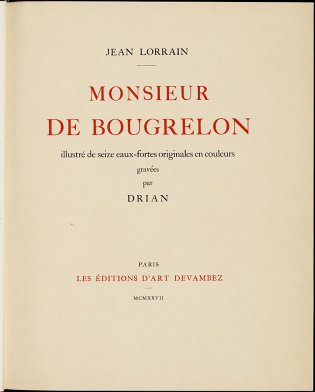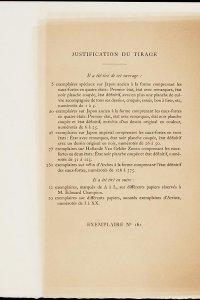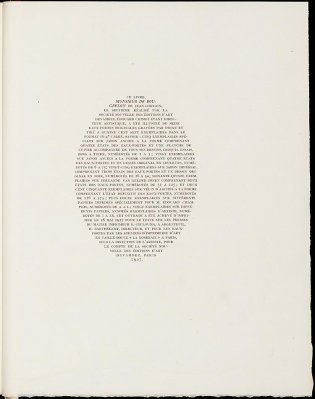Monsieur de Bougrelon
Year: 1927
Author: Jean Lorrain (1885 - 1906)
Artist: Adrien Étienne Drian (1885 - 1961)
Publisher: Les Éditions d'Art Devambez
Illustrated editions
Monsieur de Bougrelon appeared in 1897, at the end of Lorrain's life, and although it did bring him some degree of fame, there was something ambiguous about his position as journalist with artistic ambitions. He would never hesitate to use texts (even those of others) more than once. His novels were collages of articles and chronicles that had appeared previously. After his death, the Bougrelon story was published a few times in illustrated editions. In 1928, A. Brodovitch illustrated the text with fascinating wood engravings that were influenced by Cubism. A year before, Éditions d'art Devambez published a hefty edition with 16 colour etchings by Adrien Étienne Drian in an edition of 407 copies. For the same publisher, Drian also illustrated La canne de jaspe by Henry de Régnier (1924). Devambez was a renowned publisher, whose books were distributed by another publisher (Georges Crès) from 1923 onwards. The economic depression caused the market for illustrated editions to collapse, but André Devambez then opened a gallery of his own, where deluxe editions were presented for a short time. He was a painter of genre paintings himself.
Drian painted portraits and worked for the theatre and for magazines, such as La gazette du bon ton and Femina. The colour etchings for this book only rarely display his specialty (female figures): there is one illustration in which famous paintings of women are portrayed. As in most editions of Monsieur de Bougrelon, Amsterdam plays only a minor role in the illustrations, although it is more prominent in this work: there are city scenes with canals and stepped gables;there are of course windmills, and even armorial bearings. The colourfully dressed figures in the book also catch the eye: Bougrelon, Barbara's monkey; the dolled-up poodle; and the noble deer hunters, sewn into their costumes, depicted as centaurs.



![Monsieur de Bougrelon, pagina [21] met ets door Drian](/sites/default/files/styles/galerie/public/images/monsieur-de-bougrelon-p21.jpg?h=1f508818&itok=1IMTQhnW)

![Monsieur de Bougrelon, pagina [143] met ets door Drian](/sites/default/files/styles/galerie/public/images/monsieur-de-bougrelon-p143.jpg?h=823c10a2&itok=Hdut2ZCB)

